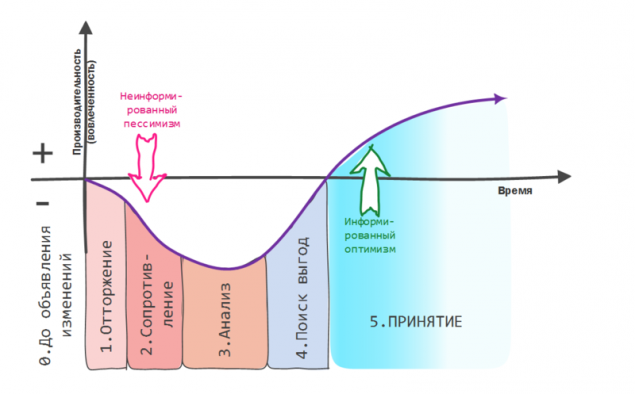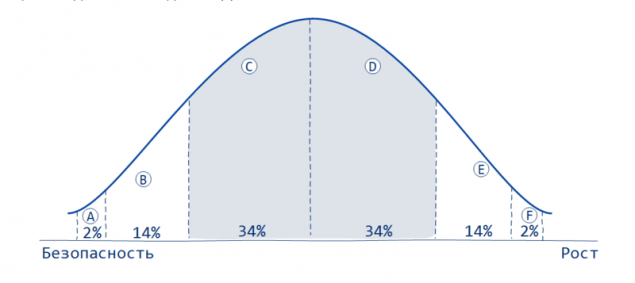583
Overcoming resistance to change
Resistance to change not rarely becomes a serious obstacle to the implementation of various projects: implementation of new information systems, management techniques, organizational change and other projects which affect the employees ' work.
What is the resistance to change, where it comes from and how to overcome it?

Denial, anger, bargaining...
There is a misconception that resistance to change is a conscious action of employees to ensure that everything was "as before". In fact, resistance to change is due to the psychology of human behavior and often they do not even realize.
Renowned psychologist Virginia Satir, analyze how people perceive the changes in their lives, called their source "alien element". No matter what it is. It can be an attack of a serious illness or a new leader with far-reaching plans. They have in common is that these alien elements deprives a person of peace. People begin to experience confusion and irritation because of the fact that we no longer feel the ground beneath your feet and the stability of the near future. According to Satir, this painful phase is inevitable and it occurs after a device and the subsequent adoption of a new reality.
Another model, described by Elizabeth Kubler-Ross in "On death and dying", in the books on change management. Kubler-Ross researched the psychology of the doomed patients, but despite this, the insights her work has interested in professional management. Kubler-Ross has identified five stages of psychological state of a person on the way to the inevitable: denial, anger, bargaining (what can I do to turn events around?), depression and eventually, acceptance. Not necessarily in that order, but similar sentiments employee experiencing organizational change.
Not be ordered to live in a new way , In practice, the resistance to change is not expressed in intentional actions aimed against the changes, but first and foremost, to reduce the performance. Employees do not begin to do something "evil", often they simply cease to do anything, or not doing what you need (operating by inertia, the old fashioned way). And it happens not from malice, but because of the psychological characteristics of human behavior, in his reactions to change.
Hence, an important conclusion – people should be forced not to resist. Not be ordered "to live a new life" is the first mistake made by many implementers. Use alone clerks of techniques only undermines employees, makes their future even more uncertain. It only strengthens resistance.
So resistance to change is a decrease in performance or employee engagement in the work, due to the negative expectations. The degree of resistance or support in the change process describes how the curve changes.

Before the announcement about changes to performance and employee engagement in work is at a constant average level. There is no reason to change it.
In change management there are 5 stages of the transformation process:
1. Rejection
Immediately following the announcement about the changes.
"Why change something, so all is well" — so say all, and always, when the first time I hear about changes, when you do not understand the motives, objectives and consequences of changes.
2. Resistance
"It used to be better", "Here in our previous system" and so on. Officials fear that the changes will push them out of their comfort zone and they will have to make some effort. Staff is all ways trying to prove that it was better before.
Not infrequently, the resistance at this stage takes a hysterical form. It is a period of unproductive disputes.
3. Analysis
At this stage of the projects fail!
At least stop the resistance of employees fall into the "stop status" is a form of depression in which a person does nothing. At this stage there is awareness of the inevitability of change. Employees analyze the possible consequences, understand what is required of them.
At this stage, employees need information makeup, a clear indication of what to do and what is not, who is responsible for what. If not, the project down on the brakes.
4. Interest
Once employees understand and accept that change is inevitable, they begin to seek benefits new situations. Opening benefits and opportunities to form positive changes, employees become advocates of change.
5. The adoption
New rules, tools and practices become the norm, employees understand that they open up new opportunities and allow you to more effectively solve problems.
How to manage this?
In overcoming resistance to change are critical three factors: People, Motivation and information.
People
Attitudes towards change is based on the scale of human values: if the highest value for him is security and stability, he will make any changes if it is important for the growth and development, he will welcome them. According to the relationship of people to change sociologists divide all people into groups:

A. 2% of the "reluctant" (unwilling to change anything)
B. 14% — "wait" (I'm afraid to make a mistake, require that evidence)
C. and 34% "inert majority" (trying to detect errors and threats that require pre-checking)
D. 34% — "less inert majority" (trying to identify new opportunities, participate in discussions)
E. 14% — "test" (they love new ideas and perspectives; they are ready to test them, they do not buy "product" and "the promise", striving to be at the forefront)
F. 2% — "inventors by nature" (always think in new ways and want to change everything)
Depending on which group includes employees, the motive for joining the transformation for them will be different. Ways to overcome resistance to them will also be different.
16% of people (E,F) – innovators. Well, when the implementation team consists of such people – this ensures the success of reforms. The motivation of innovators – "we made it", "we first".
34% (D) — inert, appreciate stability and permanence, but is not averse to use the new features. Such employees need to demonstrate what benefits and new opportunities they will receive from innovation. Maybe for some it will be a new position or a new job. For this group, first and foremost, an important personal perspective.
34% © – inert, cautious, afraid, gets worse, as well as for group D to them in the first place, it is important the impact of the change on them personally. For this group of employees need to show that in their lives, nothing will change fundamentally: salary, chief, duties – in General, it will also, as now, will change some of the details. At rest, these employees will follow the group D, looking at what with them, nothing happens, and taking after them, everything changes.
14% (B) – will consider all changes a mistake and a bad idea. On the course changes, these employees usually active influence. But it is very important that they were not in the team introduction. One member of the team is able to stop the process.
2% (A) – militant reactionaries. Even when everything is going to happen, they be nostalgic for the old days. It is very important to know these employees in their company. At the time of the change their best to go on holiday to avoid their destructive effects.
Motivation
One of the main tasks of the implementation team is to find the benefit from changes for each employee, which these changes will affect. You need to clearly realize that change is stressful for employees and read it can only help right motivation. The nature of this motivation depends on which of the groups in relation to changes of employee.
Informing
Often, in the process of change the role of information is greatly underestimated. Have to see how the team of revolutionaries long for something develops, then all declare that we need to live a new life. This is a mistaken tactic, most often, it leads to various losses.
The organizational system is a community of people. Don't have any illusions. On the work of the "group of revolutionaries" will be known almost immediately. And in the absence of official information about their work, it will be replaced with speculation and rumors that are not positive. People in General tend to prepare for the worst, and in our country especially. As a result, by the time of the announcement of the change will have a negative image of inert most will already be configured against the changes.
Therefore, it is important to start informing about the changes at once, at the beginning of the training to them. You need to give a reasonable explanation of their necessity, the objectives of the changes about to set deadlines.
Don't have to talk about all the details, but you need to convey the idea that the changes will be positive and will benefit – it will help in the future to cope with resistance to change. published
P. S. And remember, only by changing their consumption — together we change the world! ©
Join us in Facebook and in Vkontakte, and we're Classmates
Source: megamozg.ru/post/19016/
What is the resistance to change, where it comes from and how to overcome it?

Denial, anger, bargaining...
There is a misconception that resistance to change is a conscious action of employees to ensure that everything was "as before". In fact, resistance to change is due to the psychology of human behavior and often they do not even realize.
Renowned psychologist Virginia Satir, analyze how people perceive the changes in their lives, called their source "alien element". No matter what it is. It can be an attack of a serious illness or a new leader with far-reaching plans. They have in common is that these alien elements deprives a person of peace. People begin to experience confusion and irritation because of the fact that we no longer feel the ground beneath your feet and the stability of the near future. According to Satir, this painful phase is inevitable and it occurs after a device and the subsequent adoption of a new reality.
Another model, described by Elizabeth Kubler-Ross in "On death and dying", in the books on change management. Kubler-Ross researched the psychology of the doomed patients, but despite this, the insights her work has interested in professional management. Kubler-Ross has identified five stages of psychological state of a person on the way to the inevitable: denial, anger, bargaining (what can I do to turn events around?), depression and eventually, acceptance. Not necessarily in that order, but similar sentiments employee experiencing organizational change.
Not be ordered to live in a new way , In practice, the resistance to change is not expressed in intentional actions aimed against the changes, but first and foremost, to reduce the performance. Employees do not begin to do something "evil", often they simply cease to do anything, or not doing what you need (operating by inertia, the old fashioned way). And it happens not from malice, but because of the psychological characteristics of human behavior, in his reactions to change.
Hence, an important conclusion – people should be forced not to resist. Not be ordered "to live a new life" is the first mistake made by many implementers. Use alone clerks of techniques only undermines employees, makes their future even more uncertain. It only strengthens resistance.
So resistance to change is a decrease in performance or employee engagement in the work, due to the negative expectations. The degree of resistance or support in the change process describes how the curve changes.

Before the announcement about changes to performance and employee engagement in work is at a constant average level. There is no reason to change it.
In change management there are 5 stages of the transformation process:
1. Rejection
Immediately following the announcement about the changes.
"Why change something, so all is well" — so say all, and always, when the first time I hear about changes, when you do not understand the motives, objectives and consequences of changes.
2. Resistance
"It used to be better", "Here in our previous system" and so on. Officials fear that the changes will push them out of their comfort zone and they will have to make some effort. Staff is all ways trying to prove that it was better before.
Not infrequently, the resistance at this stage takes a hysterical form. It is a period of unproductive disputes.
3. Analysis
At this stage of the projects fail!
At least stop the resistance of employees fall into the "stop status" is a form of depression in which a person does nothing. At this stage there is awareness of the inevitability of change. Employees analyze the possible consequences, understand what is required of them.
At this stage, employees need information makeup, a clear indication of what to do and what is not, who is responsible for what. If not, the project down on the brakes.
4. Interest
Once employees understand and accept that change is inevitable, they begin to seek benefits new situations. Opening benefits and opportunities to form positive changes, employees become advocates of change.
5. The adoption
New rules, tools and practices become the norm, employees understand that they open up new opportunities and allow you to more effectively solve problems.
How to manage this?
In overcoming resistance to change are critical three factors: People, Motivation and information.
People
Attitudes towards change is based on the scale of human values: if the highest value for him is security and stability, he will make any changes if it is important for the growth and development, he will welcome them. According to the relationship of people to change sociologists divide all people into groups:

A. 2% of the "reluctant" (unwilling to change anything)
B. 14% — "wait" (I'm afraid to make a mistake, require that evidence)
C. and 34% "inert majority" (trying to detect errors and threats that require pre-checking)
D. 34% — "less inert majority" (trying to identify new opportunities, participate in discussions)
E. 14% — "test" (they love new ideas and perspectives; they are ready to test them, they do not buy "product" and "the promise", striving to be at the forefront)
F. 2% — "inventors by nature" (always think in new ways and want to change everything)
Depending on which group includes employees, the motive for joining the transformation for them will be different. Ways to overcome resistance to them will also be different.
16% of people (E,F) – innovators. Well, when the implementation team consists of such people – this ensures the success of reforms. The motivation of innovators – "we made it", "we first".
34% (D) — inert, appreciate stability and permanence, but is not averse to use the new features. Such employees need to demonstrate what benefits and new opportunities they will receive from innovation. Maybe for some it will be a new position or a new job. For this group, first and foremost, an important personal perspective.
34% © – inert, cautious, afraid, gets worse, as well as for group D to them in the first place, it is important the impact of the change on them personally. For this group of employees need to show that in their lives, nothing will change fundamentally: salary, chief, duties – in General, it will also, as now, will change some of the details. At rest, these employees will follow the group D, looking at what with them, nothing happens, and taking after them, everything changes.
14% (B) – will consider all changes a mistake and a bad idea. On the course changes, these employees usually active influence. But it is very important that they were not in the team introduction. One member of the team is able to stop the process.
2% (A) – militant reactionaries. Even when everything is going to happen, they be nostalgic for the old days. It is very important to know these employees in their company. At the time of the change their best to go on holiday to avoid their destructive effects.
Motivation
One of the main tasks of the implementation team is to find the benefit from changes for each employee, which these changes will affect. You need to clearly realize that change is stressful for employees and read it can only help right motivation. The nature of this motivation depends on which of the groups in relation to changes of employee.
Informing
Often, in the process of change the role of information is greatly underestimated. Have to see how the team of revolutionaries long for something develops, then all declare that we need to live a new life. This is a mistaken tactic, most often, it leads to various losses.
The organizational system is a community of people. Don't have any illusions. On the work of the "group of revolutionaries" will be known almost immediately. And in the absence of official information about their work, it will be replaced with speculation and rumors that are not positive. People in General tend to prepare for the worst, and in our country especially. As a result, by the time of the announcement of the change will have a negative image of inert most will already be configured against the changes.
Therefore, it is important to start informing about the changes at once, at the beginning of the training to them. You need to give a reasonable explanation of their necessity, the objectives of the changes about to set deadlines.
Don't have to talk about all the details, but you need to convey the idea that the changes will be positive and will benefit – it will help in the future to cope with resistance to change. published
P. S. And remember, only by changing their consumption — together we change the world! ©
Join us in Facebook and in Vkontakte, and we're Classmates
Source: megamozg.ru/post/19016/























